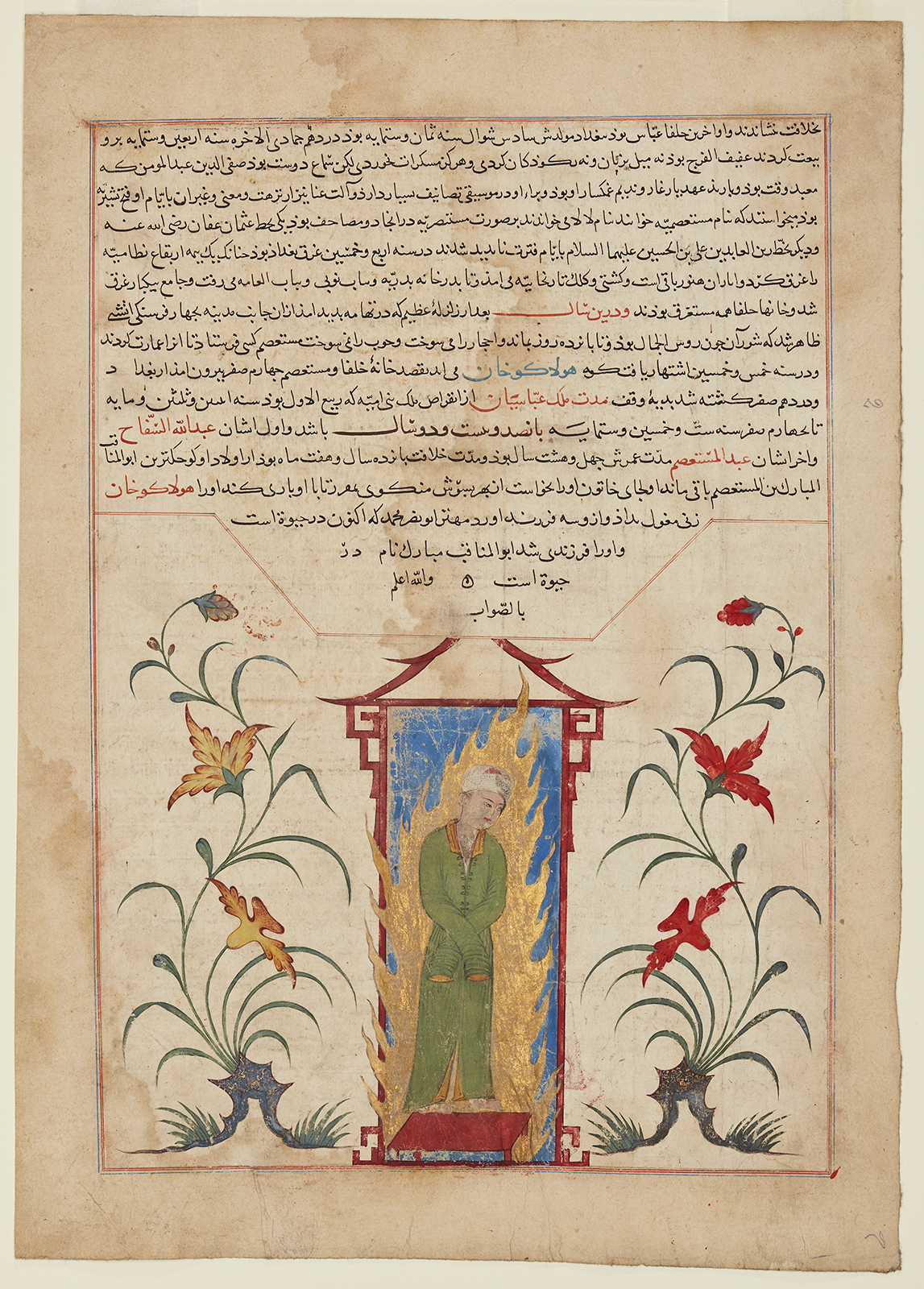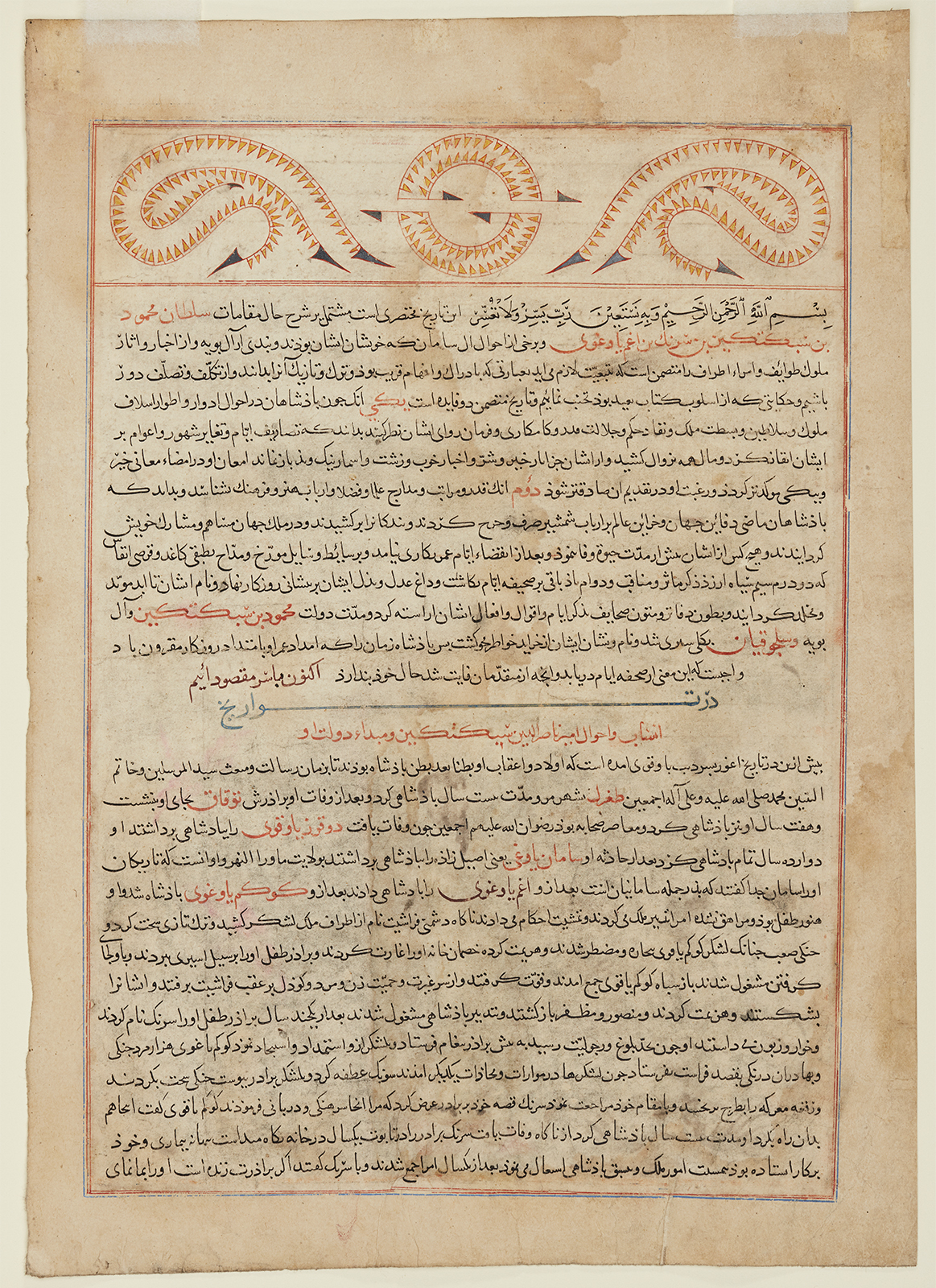Click on the image to zoom
The last of the Abbasid caliphs, Mustaʿsim (r. 1242–58)
- Accession Number:AKM89
- Place:Iran, Herat
- Dimensions:42.4 x 30.3 cm
- Date:early 15th century
- Materials and Technique:ink, watercolour, and gold pigment on paper
This folio, along with two others in the Aga Khan Museum Collection (AKM40 and AKM41), comes from a manuscript assembled at the court of Shahrukh (d. 1447) and disassembled by the art dealer Émile Tabbagh in the 1920s and 30s. The manuscript’s content draws primarily from a world history prepared by Rashid al-Din (d. 1318) for the Mongol Ilkhan Oljeitu in 1307. It is not a simple copy of Rashid al-Din’s work, but rather a hybrid manuscript with a tangled history made even more complex by its dispersal. This folio is one of a group of folios that were originally prepared under Rashid al-Din’s own supervision and later incorporated into the Timurid manuscript.
Further Reading
This folio contains the end of the history of the Abbasid caliphate and the beginning of the Ghaznavid history. It has an impressive historical pedigree which requires care to explain. After he wrote his world history, Rashid al-Din endowed a major complex of pious and scholarly institutions, among them a scriptorium for the reproduction of manuscripts, including the Qurʾan as well as his own historical, theological, and scientific writings. At this scriptorium, artists elaborated the historical manuscripts with lavish programs of illustration. The most famous manuscript from Rashid al-Din’s scriptorium is an Arabic translation of the world history that survives in two fragments in Edinburgh and the collection of Nasser Khalili. AKM89 is one of a group of between 50 and 60 folios that match the Arabic copy and other manuscripts known to originate from Rashid al-Din’s scriptorium in their format, orthography, and paper. It is therefore likely that these folios were originally prepared in Tabriz in the 1310s, and the rest of the manuscript (including AKM40 and AKM41) was reconstructed in Herat a century later.
The manuscript from which this folio has been taken can be compared to a more famous, and still complete, manuscript now in Istanbul.[1] That manuscript similarly preserves a version of Rashid al-Din’s world history that was modified at the court of Shahrukh by his court historian Hafiz-i Abru. In the preface to the Istanbul manuscript, Hafiz-i Abru describes how Shahrukh asked him to reconstruct a fragmentary copy of the world history that had survived from Rashid al-Din’s scriptorium. The Istanbul manuscript does indeed include fragments from an original manuscript from Rashid al-Din’s scriptorium, with the remaining sections recopied by Hafiz-i Abru himself. As part of that project, Hafiz-i Abru replaced Rashid al-Din’s history of the pre-Islamic period with a version of his own. Hafiz-i Abru’s pre-Islamic history also appears in the dispersed manuscript that this folio has been taken from.
Because of the similarities between the Istanbul manuscript and the dispersed manuscript from which this folio has been taken, the latter has long been considered to be a copy of the former. However, the dispersed manuscript preserves some sections of Rashid al-Din’s text which Hafiz-i Abru had modified for the manuscript in Istanbul.” This is a bit more general and less committal, reflecting my changing views on the modifications. Given that fact, as well as the fact that the dispersed manuscript includes a fragment of an original copy from Rashid al-Din’s scriptorium in Tabriz, it must be considered a second, separate project with the same aim, namely preserving and reconstructing fragmentary manuscripts of Rashid al-Din’s history.
The remnant manuscript from which this and the other painted pages have been removed includes four folios copied in the late 19th or early 20th century, presumably as replacement folios for pages as they were removed from the manuscript.[2] One of these replacement folios contains the text of the first page of Ghaznavid history found on the verso of this folio. The other three replacement folios all correspond to pages that seem to have been removed from the manuscript very early. There is no evidence that this folio was removed particularly early, but it may be that it was removed and exhibited separately by Émile Tabbagh before other pages were cut from the manuscript.
— Stefan Kamola
Notes
[1] Istanbul TSM H.1653.
[2] At least two of these folios, Art and History Trust ms. 22, fols. 1-2, are copied on 19th-century Venetian paper with the watermark F.F. Palazzuoli that is also found on at least one manuscript (Princeton University Library ms. Garrett 3382Y) dated to 1864.
References
Ettinghausen, Richard. “An illuminated manuscript of Ḥānfiẓ-i Abrū in Istanbul,” Kunst des Orients 2 (1955): 30-44.
Ghiasian, Mohamad Reza. “The ‘historical style’ of painting for Shahrukh and its revival in the dispersed manuscript of Majmaʿ al-Tawarikh,” Iranian Studies 48.6 (2015): 871–903.
---. Lives of the Prophets: the Illustrations to Hafiz-i Abru’s “Assembly of Chronicles.” Leiden: Brill, 2018. ISBN: 9789004377226.
Martinovitch, Nicholas N. “Die verlorene Handschrift von Rašīd ad-Dīn,” Artibus Asiae 5.2/4 (1935), 213–21.
Rashid al-Din Fadl Allah al-Hamadani. Tarikh-e Iran va Islam. ed. Muhammad Raushan, Tehran: Miras-i Maktub, 2013.
---. Tarikh-e Samaniyan va Buwayhiyan va Ghaznaviyan. ed. Muhammad Raushan, Tehran, Miras-i Maktub, 2007.
Soudavar, Abolala. Art of the Persian Courts: Selections from the Art and History Trust Collection. New York: Random House, 1992.
Tauer, Felix. “Les manuscrits persans historiques des bibliothèques de Stamboul, Ire partie,” Archiv Orientální 3.1 (1931): 87–118. ISSN: 0044-8699
Welch, Anthony. Collection of Islamic Art, Vol. I, Geneva: Château de Bellerive, 1978.
Note: This online resource is reviewed and updated on an ongoing basis. We are committed to improving this information and will revise and update knowledge about this object as it becomes available.




